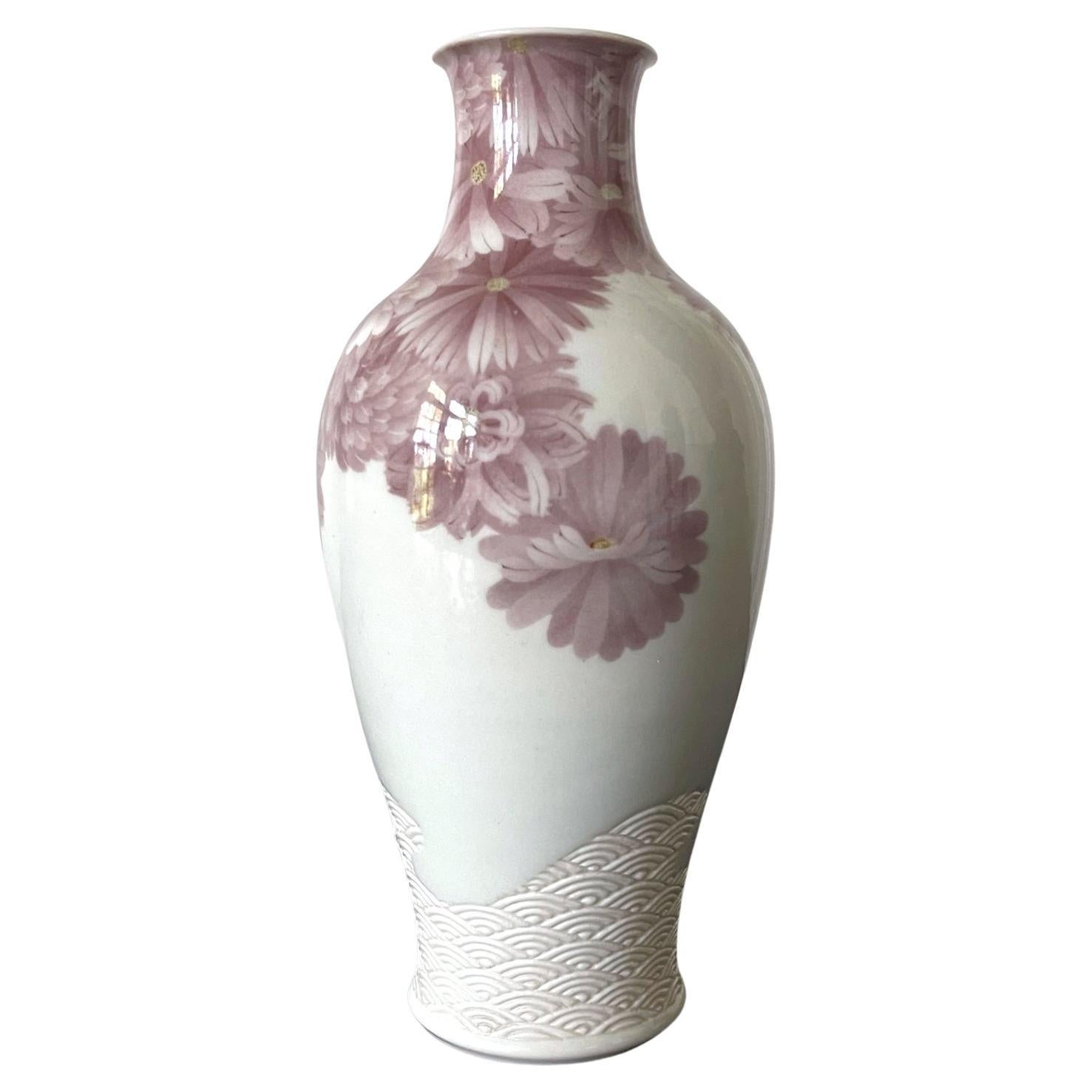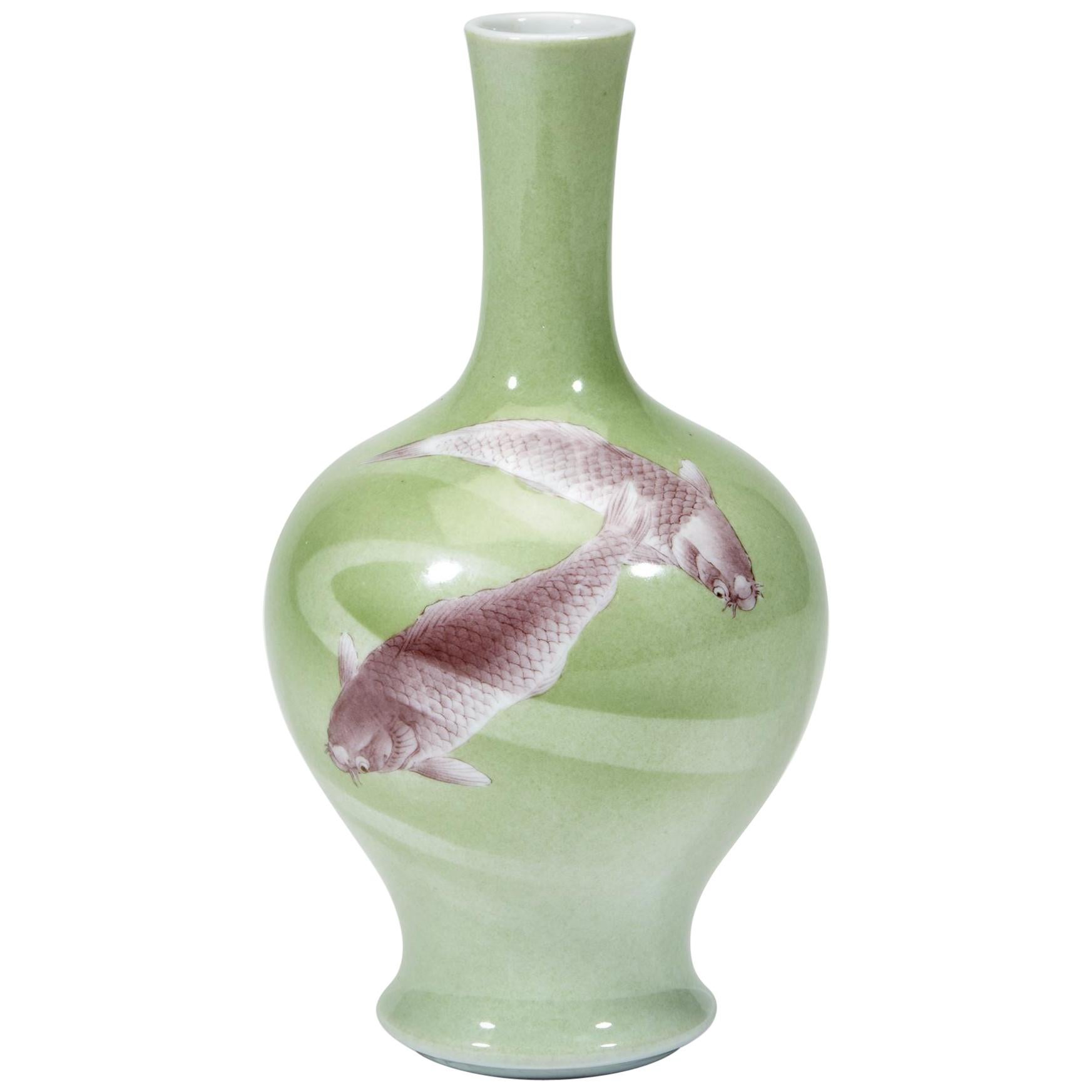Items Similar to Antique Awaji Grey Crackle Glaze Ceramic Vase - Meiji Period - Japan - C.1910
Want more images or videos?
Request additional images or videos from the seller
1 of 9
Antique Awaji Grey Crackle Glaze Ceramic Vase - Meiji Period - Japan - C.1910
About the Item
Antique Awaji ceramic vase - grey crackle glaze - cold painted decoration with red and gilt enamel bird on a branch with flower and leaves - old faint inventory numbers to the base - unsigned - Japan - circa 1910.
Excellent antique condition - firing flaws and uneven glaze in areas (common with antique hand made items) - enamel and gilding loss - no cracks - no chips - no restoration - signs of age and use.
Size/Dimensions - Medium - 3 7/8" (10 cm.) Diameter x 8" (20.3 cm.) High.
- Creator:Awaji Pottery (Maker)
- Dimensions:Height: 8 in (20.32 cm)Diameter: 3.88 in (9.86 cm)
- Style:Japonisme (Of the Period)
- Materials and Techniques:
- Place of Origin:
- Period:
- Date of Manufacture:1910-1919
- Condition:Wear consistent with age and use.
- Seller Location:Chatham, CA
- Reference Number:1stDibs: LU7265232505902
About the Seller
5.0
Gold Seller
These expertly vetted sellers are highly rated and consistently exceed customer expectations.
Established in 1990
1stDibs seller since 2022
71 sales on 1stDibs
Typical response time: <1 hour
- ShippingRetrieving quote...Ships From: Chatham, Canada
- Return PolicyA return for this item may be initiated within 3 days of delivery.
More From This SellerView All
- Antique Meiji Wucai Style Porcelain Jar & Cover, Japan, Early 20th CenturyLocated in Chatham, ONAntique Meiji period Wucai style hand painted porcelain jar and cover - featuring flowering branches of multicolor blossoms and leaves - all on a white ground with pale blue rim to t...Category
Early 20th Century Japanese Meiji Ceramics
MaterialsPorcelain
- Vintage Glazed Ceramic Vase - Dimpled Sides - Unsigned - Late 20th CenturyLocated in Chatham, ONVintage ceramic vase with dimpled sides and splash/drip crackle glaze - wheel thrown body - glazed interior - unsigned - Japan (likely) - late 20th century. Fair vintage condition...Category
Late 20th Century Japanese Anglo-Japanese Ceramics
MaterialsCeramic
- Vintage Asian Celadon Glazed Vase, Bamboo Form, Unsigned, Mid 20th CenturyLocated in Chatham, ONVintage Asian porcelain vase with celadon glaze - bamboo form - unsigned - mid 20th century. Excellent vintage condition - no loss - no dama...Category
Mid-20th Century Asian Qing Ceramics
MaterialsPorcelain
- Kangxi Apple Green Crackle Glaze Baluster Vase/Lamp, China, Early 18th CenturyLocated in Chatham, ONRare Kangxi Dynasty (1654-1722) apple green over white crackle glazed baluster shaped ceramic vase/lamp - white crackle glazed interior and base - large size - electrified/drilled mi...Category
Antique Early 18th Century Chinese Qing Ceramics
MaterialsPorcelain
- Ming Style Double Gourd Crackle Glaze Ceramic Vase - Signed - Mid-20th CenturyLocated in Chatham, ONMing style double gourd ceramic vase with crackle glaze - signed - country of origin unknown - mid 20th century. Excellent vintage condition - no loss - no damage - no restoration...Category
Mid-20th Century Chinoiserie Vases
MaterialsCeramic
- Art Deco Turquoise Crackle Glaze Vase, Belgium, Circa 1930'sBy Boch Freres Keramis, Charles Catteau for Boch FreresLocated in Chatham, ONExtraordinary Art Deco turquoise crackle glaze vase - featuring a trumpet form shape on a plinth base with twin handles - signed on the base (model number 1344-O) - Belgium - circa 1...Category
Mid-20th Century Belgian Art Deco Vases
MaterialsCeramic
You May Also Like
- Japanese Mishima Ceramic Vase Meiji PeriodLocated in Atlanta, GAA Japanese long neck slender ceramic vase in the style of Mishima, circa 19th century, Meiji period. Mishima pottery was originally imported from three islands in Taiwan and then fro...Category
Antique 19th Century Japanese Japonisme Ceramics
MaterialsCeramic
- Japanese Ceramic Vase by Ito Tozan I Meiji PeriodBy Ito Tozan ILocated in Atlanta, GAThis stoneware vase of a jar form was finely decorated with low relief carving and delicate colored glazes depicting bundles of peony flowers. It was made by Ito Tozan I (1846-1920) circa 1890-1900s in the late Meiji Period. The color pallet was both bold and subtle, with dark green and rusty leaves with golden outlines and white and light yellow peony petals covering much of the surface. Impressed with potter's mark on the base. Examples of two pieces by Ito Tozan I were in the collection of MNAAG (Guimet) Paris. Inventory no. MG 13790 an 13792. A vase with similar shape and decoration techniques is featured as Lot 1340 Fine Japanese Art, 13 Sep 2017 Bonhams New York Tozan Ito I established his ceramic business in Kyoto 1867. His studio made both porcelain and stoneware in a style some considered Satsuma while they retained a sophistication of Kyoto ware...Category
Antique 1890s Japanese Japonisme Ceramics
MaterialsCeramic
- Japanese Porcelain Vase Makuzu Kozan Meiji PeriodBy Makuzu KozanLocated in Atlanta, GAA striking blue and white vase from the studio of Japanese Potter Makuzu Kozan, also known as Miyagawa Kozan (1842–1916), one of the most established and collected ceramist from Meiji Period. Born as Miyagawa Toranosuke, Kozan established his pottery studio in Yokohama circa 1870s and later became one of the appointed artists to the Japanese Imperial household. His work was exhibited in many international fairs that the Meiji government participated at the turn of the century and won many grand prizes. Of a relatively large size, this vase is decorated with underglaze cobalt blue using the novel technique developed by Kozan called Fuki-e (the blow painting). As a result, the bamboos appear took on a three-dimensional quality as if appearing in a mist. Known as one of the most creative ceramists, circa 1887, Kozan started experimenting with new chemical colors from the West in the format of his porcelain glaze. New colors allowed him to create underglaze design that appeared bright, smooth and glossy. He even invented his own receipt of cobalt blue to achieve a much brighter yet softer shade, as evident on this vase. To create landscape that is realistic and dimensional, more common in the western paintings, he was inspired by the native Japanese ink painting technique developed around 1900 by Yokoyama Taikan...Category
Antique Early 1900s Japanese Japonisme Ceramics
MaterialsCeramic
- Japanese Ceramic Vase with Delicate Carvings by Makuzu Kozan Meiji PeriodBy Makuzu KozanLocated in Atlanta, GAA delicate and rare Japanese ceramic vase by the important Meiji imperial potter Makuzu Kozan (1842-1916) circa 1887-1910. Dated to his underglaze phase post 1887 after he successful...Category
Antique 1890s Japanese Japonisme Ceramics
MaterialsCeramic
- One of The Two Japanese Ceramic Vases Makuzu Kozan Meiji PeriodBy Makuzu KozanLocated in Atlanta, GATwo small nearly identical ceramic vases by Japanese Meiji imperial potter Makuzu Kozan (1842-1916), circa 1890-1900s. The vases were made in the form of jarlet with swelled shoulder...Category
Antique Late 19th Century Japanese Japonisme Ceramics
MaterialsCeramic
- Fine Japanese Ceramic Vase Makuzu Kozan Meiji PeriodBy Makuzu KozanLocated in Atlanta, GAA Japanese long neck porcelain vase circa 1900-1910s by the studio of Miyagawa Kozan (1842–1916), one of the most established and collected Japanese ceramist from the end of Meiji Period. Commonly known as Makuzu Kozan, which also appears as the signature on his work, his originally birth name was Miyagawa Toranosuke. He was the appointed artist to the Japanese Imperial household and his work was exhibited in many international fairs that the Meiji government participated at the turn of the century. This vase features an elegant Classic form with a slender neck and slightly flared mouth above a baluster body. It was finely painted with two swimming carps in a copper red underglaze among green ribbons like waves. The background display a brilliant verdant green overall, Around the fish a poetic hazy effect was emphasized for a visual complexity by Fuki-e (the blow painting), an invention in Kozan's studio. The new technical development of chemical colors from the west was embraced circa 1900s in Kozan studio. This empowered the more creative experiments with not only colors, but also concept of dimension, which led Makuzu Kozan's work to become a bridge between East and West aesthetics. This is particularly evident in this vase with the Masterly details of the brush strokes, the expertly employment of gradient of color, and a very realistic and detailed rendering of the fish and their vivid motions. For two similar examples of Kozan's work with similar carps decoration, see Page 148-149 of the book: Sekai ni Aisa Reta ya Kimono Miyagawa Kozan Makuzu...Category
Early 20th Century Japanese Meiji Ceramics
MaterialsCeramic
Recently Viewed
View AllMore Ways To Browse
Antique Inventory
Antique Numbers
Crackle Ceramic
Antique Japanese Pottery
Japanese Antique Pottery
Pottery Bird
Japanese Signed Ceramic
Japanese Old Pottery
Signed 20th Century Japanese Vase
Crackle Pottery
Birds On Branches Flowers
Antique Crackle Glaze
Signed Japanese Pottery
Grey Antique Glaze
Antique Crackle Paint
Crackled Red
Japanese Red Ceramic Vase
Antique Hand Painted Pottery Vase





